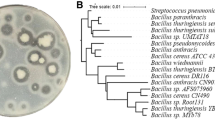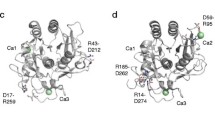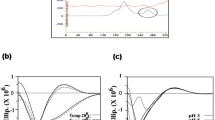Abstract
The plausible explanation behind the stability of thermophilic protein is still yet to be defined more clearly. Here, an in silico study has been undertaken by investigating the sequence and structure of protease from thermophilic (tPro) bacteria and mesophilic (mPro) bacteria. Results showed that charged and uncharged polar residues have higher abundance in tPro. In extreme environment, the tPro is stabilized by high number of isolated and network salt bridges. A novel cyclic salt bridge is also found in a structure of tPro. High number of metal ion-binding site also helps in protein stabilization of thermophilic protease. Aromatic-aromatic interactions also play a crucial role in tPro stabilization. Formation of long network aromatic-aromatic interactions also first time reported here. Finally, the present study provides a major insight with a newly identified cyclic salt bridge in the stability of the enzyme, which may be helpful for protein engineering. It is also used in industrial applications for human welfare.






Similar content being viewed by others
Data Availability
Not applicable.
References
Sawle, L., & Ghosh, K. (2011). How do thermophilic proteins and proteomes withstand high temperature? Biophysical Journal, 101(1), 217–227. https://doi.org/10.1016/j.bpj.2011.05.059.
Wang, Q., Cen, Z., & Zhao, J. (2015). The survival mechanisms of thermophiles at high temperatures: an angle of omics. Physiology., 30(2), 97–106. https://doi.org/10.1152/physiol.00066.2013.
Liu, J., Yu, H., & Shen, Z. (2008). Insights into thermal stability of thermophilic nitrile hydratases by molecular dynamics simulation. Journal of Molecular Graphics and Modelling, 27(4), 529–535. https://doi.org/10.1016/j.jmgm.2008.09.004.
Kumar, S., Tsai, C. J., Ma, B., & Nussinov, R. (2000). Contribution of salt bridges toward protein thermostability. Journal of Biomolecular Structure and Dynamics, 17(sup1), 79–85. https://doi.org/10.1080/07391102.2000.10506606.
Chan, C. H., Yu, T. H., & Wong, K. B. (2011). Stabilizing salt-bridge enhances protein thermostability by reducing the heat capacity change of unfolding. PLoS One, 6(6), e21624. https://doi.org/10.1371/journal.pone.0021624.
Missimer, J. H., Steinmetz, M. O., Baron, R., Winkler, F. K., Kammerer, R. A., Daura, X., & Van Gunsteren, W. F. (2007). Configurational entropy elucidates the role of salt-bridge networks in protein thermostability. Protein Science., 16(7), 1349–1359. https://doi.org/10.1110/ps.062542907.
Kumar, S., Ma, B., Tsai, C. J., & Nussinov, R. (2000). Electrostatic strengths of salt bridges in thermophilic and mesophilic glutamate dehydrogenase monomers. Proteins: Structure, Function, and Bioinformatics, 38(4), 368–383. https://doi.org/10.1002/(SICI)1097-0134(20000301)38.
Sawant, R., & Nagendran, S. (2014). Protease: an enzyme with multiple industrial applications. World Journal of Pharmacy and Pharmaceutical Sciences., 3(6), 568–579.
Walsh, G. (2015). Industrial enzymes: proteases and carbrohydrases. Proteins: biochemistry and biotechnology., 9, 327–369. https://doi.org/10.1002/9781119117599.ch12.
Gupta, R., Beg, Q., & Lorenz, P. (2002). Bacterial alkaline proteases: molecular approaches and industrial applications. Applied microbiology and biotechnology., 59(1), 15–32. https://doi.org/10.1007/s00253-002-0975-y.
Paul, T., Halder, S. K., Das, A., Ghosh, K., Mandal, A., Payra, P., Barman, P., Mohapatra, P. K., Pati, B. R., & Mondal, K. C. (2015). Production of chitin and bioactive materials from black tiger shrimp (Penaeus monodon) shell waste by the treatment of bacterial protease cocktail. 3. Biotech., 5(4), 483–493. https://doi.org/10.1007/s13205-014-0250-9.
Paul, T., Das, A., Mandal, A., Jana, A., Halder, S. K., Mohapatra, P. K., Pati, B. R., & Mondal, K. C. (2014). Smart cleaning properties of a multi tolerance keratinolytic protease from an extremophilic Bacillus tequilensis hsTKB2: prediction of enzyme modification site. Waste and Biomass Valorization., 5(6), 931–945. https://doi.org/10.1007/s12649-014-9310-y.
Sethi, B. K., Jana, A., Nanda, P. K., Das Mohapatra, P. K., & Sahoo, S. L. (2016). Thermostable acidic protease production in Aspergillus terreus NCFT 4269.10 using chickling vetch peels. Journal of Taibah University for Science., 10(4), 571–583. https://doi.org/10.1016/j.jtusci.2015.11.001.
Banerjee, A., Pal, S., Paul, T., Mondal, K. C., Pati, B. R., Sen, A., & Mohapatra, P. K. (2014). Characterization of Bacillus anthracis proteases through protein-protein interaction: an in silico study of anthrax pathogenicity. TANG., 4(1), 51–62 https://doi.org/10.5667/tang.2013.0031.
Guangrong H, Tiejing Y, Po H, Jiaxing J. Purification and characterization of a protease from thermophilic Bacillus strain HS08. African Journal of Biotechnology. 2006;5(24). http://www.academicjournals.org/AJB
Merheb, C. W., Cabral, H., Gomes, E., & Da-Silva, R. (2007). Partial characterization of protease from a thermophilic fungus, Thermoascus aurantiacus, and its hydrolytic activity on bovine casein. Food Chemistry., 104(1), 127–131. https://doi.org/10.1016/j.foodchem.2006.11.010.
Lasa, I., & Berenguer, J. (1993). Thermophilic enzymes and their biotechnological potential. Microbiologia., 9(2), 77–89.
Cowan, D., Daniel, R., & Morgan, H. (1985). Thermophilic proteases: properties and potential applications. Trends in Biotechnology, 3(3), 68–72. https://doi.org/10.1016/0167-7799(85)90080-0.
Bruins, M. E., Janssen, A. E., & Boom, R. M. (2001). Thermozymes and their applications. Applied Biochemistry and Biotechnology, 90(2), 155–186. https://doi.org/10.1385/abab:90:2:155.
Katrolia, P., Jia, H., Yan, Q., Song, S., Jiang, Z., & Xu, H. (2012). Characterization of a protease-resistant α-galactosidase from the thermophilic fungus Rhizomucor miehei and its application in removal of raffinose family oligosaccharides. Bioresource technology., 110, 578–586. https://doi.org/10.1016/j.biortech.2012.01.144.
Tavano, O. L., Berenguer-Murcia, A., Secundo, F., & Fernandez-Lafuente, R. (2018). Biotechnological applications of proteases in food technology. Comprehensive Reviews in Food Science and Food Safety, 17(2), 412–436. https://doi.org/10.1111/1541-4337.12326.
Herrera-Marquez, O., Fernandez-Serrano, M., Pilamala, M., Jacome, M. B., & Luzon, G. (2019). Stability studies of an amylase and a protease for cleaning processes in the food industry. Food and Bioproducts Processing, 117, 64–73. https://doi.org/10.1016/j.fbp.2019.06.015.
UniProt Consortium. (2015). UniProt: a hub for protein information. Nucleic Acids Research, 43(D1), D204–D212. https://doi.org/10.1093/nar/gku989.
Pearson, W. R. (1991). Searching protein sequence libraries: comparison of the sensitivity and selectivity of the Smith-Waterman and FASTA algorithms. Genomics., 11(3), 635–650. https://doi.org/10.1016/0888-7543(91)90071-L.
Kouranov, A., Xie, L., de la Cruz, J., Chen, L., Westbrook, J., Bourne, P. E., & Berman, H. M. (2006). The RCSB PDB information portal for structural genomics. Nucleic acids research, 34(suppl_1), D302-D305. https://doi.org/10.1093/nar/gkj120
Sievers, F., Wilm, A., Dineen, D., Gibson, T. J., Karplus, K., Li, W., & Thompson, J. D. (2011). Fast, scalable generation of high-quality protein multiple sequence alignments using Clustal Omega. Molecular Systems Biology, 7(1), 539. https://doi.org/10.1038/msb.2011.75.
Clamp, M., Cuff, J., Searle, S. M., & Barton, G. J. (2004). The jalview java alignment editor. Bioinformatics, 20(3), 426–427. https://doi.org/10.1093/bioinformatics/btg430.
Gasteiger, E., Hoogland, C., Gattiker, A., Wilkins, M. R., Appel, R. D., & Bairoch, A. (2005). Protein identification and analysis tools on the ExPASy server. In The proteomics protocols handbook (pp. 571-607). Humana press. https://doi.org/10.1385/1-59259-890-0:571.
Jones, D. D. (1975). ProtScale tool: amino acid scale: refractivity. Journal of Theoretical Biology, 50(1), 167–184. https://doi.org/10.1016/0022-5193(75)90031-4.
Zakeri, A., Khoshsorour, S., Karami Fath, M., Pourzardosht, N., Fazeli, F., & Khalili, S. (2020). Structural analyses and engineering of the pmHAS enzyme to improve its functional performance: an in silico study. Journal of Carbohydrate Chemistry, 39(7), 1–20. https://doi.org/10.1080/07328303.2020.1821041.
Goddard, T. D., Huang, C. C., & Ferrin, T. E. (2007). Visualizing density maps with UCSF chimera. Journal of Structural Biology, 157(1), 281–287. https://doi.org/10.1016/j.jsb.2006.06.010.
Vriend, G. (1990). WHAT IF: a molecular modeling and drug design program. Journal of Molecular Graphics, 8(1), 52–56. https://doi.org/10.1016/0263-7855(90)80070-V.
Tian, W., Chen, C., Lei, X., Zhao, J., & Liang, J. (2018). CASTp 3.0: computed atlas of surface topography of proteins. Nucleic Acids Research, 46(W1), W363–W367. https://doi.org/10.1093/nar/gky473.
Tina, K. G., Bhadra, R., & Srinivasan, N. (2007). PIC: protein interactions calculator. Nucleic acids research, 35(suppl_2), W473-W476. https://doi.org/10.1093/nar/gkm423.
Chong, S. H., Lee, C., Kang, G., Park, M., & Ham, S. (2011). Structural and thermodynamic investigations on the aggregation and folding of acylphosphatase by molecular dynamics simulations and solvation free energy analysis. Journal of the American Chemical Society, 133(18), 7075–7083. https://doi.org/10.1021/ja1116233.
Gamage, D. G., Gunaratne, A., Periyannan, G. R., & Russell, T. G. (2019). Applicability of instability index for in vitro protein stability prediction. Protein and Peptide Letters, 26(5), 339–347. https://doi.org/10.2174/0929866526666190228144219.
Elizalde, B. E., Pilosof, A. M. R., & Bartholomai, G. B. (1991). Prediction of emulsion instability from emulsion composition and physicochemical properties of proteins. Journal of Food Science, 56(1), 116–120. https://doi.org/10.1111/j.1365-2621.1991.tb07989.x.
Coleman, R. G., & Sharp, K. A. (2010). Protein pockets: inventory, shape, and comparison. Journal of Chemical Information and Modeling, 50(4), 589–603. https://doi.org/10.1021/ci900397t.
Stank, A., Kokh, D. B., Fuller, J. C., & Wade, R. C. (2016). Protein binding pocket dynamics. Accounts of Chemical Research, 49(5), 809–815. https://doi.org/10.1021/acs.accounts.5b00516.
Gromiha, M. M., Pathak, M. C., Saraboji, K., Ortlund, E. A., & Gaucher, E. A. (2013). Hydrophobic environment is a key factor for the stability of thermophilic proteins. Proteins: Structure, Function, and Bioinformatics, 81(4), 715–721. https://doi.org/10.1002/prot.24232.
Strop, P., & Mayo, S. L. (2000). Contribution of surface salt bridges to protein stability. Biochemistry, 39(6), 1251–1255. https://doi.org/10.1021/bi992257j.
Chong, S. H., & Ham, S. (2014). Interaction with the surrounding water plays a key role in determining the aggregation propensity of proteins. Angewandte Chemie International Edition, 53(15), 3961–3964. https://doi.org/10.1002/anie.201309317.
Sindelar, C. V., Hendsch, Z. S., & Tidor, B. (1998). Effects of salt bridges on protein structure and design. Protein Science, 7(9), 1898–1914. https://doi.org/10.1002/pro.5560070906.
Anjana, R., Vaishnavi, M. K., Sherlin, D., Kumar, S. P., Naveen, K., Kanth, P. S., & Sekar, K. (2012). Aromatic-aromatic interactions in structures of proteins and protein-DNA complexes: a study based on orientation and distance. Bioinformation, 8(24), 1220–1224. https://doi.org/10.6026/97320630081220.
Lanzarotti, E., Biekofsky, R. R., Estrin, D. A., Marti, M. A., & Turjanski, A. G. (2011). Aromatic–aromatic interactions in proteins: beyond the dimer. Journal of Chemical Information and Modeling, 51(7), 1623–1633. https://doi.org/10.1021/ci200062e.
Gromiha, M. M., Oobatake, M., & Sarai, A. (1999). Important amino acid properties for enhanced thermostability from mesophilic to thermophilic proteins. Biophysical Chemistry, 82(1), 51–67. https://doi.org/10.1016/S0301-4622(99)00103-9.
Dougherty, D. A. (2013). The cation− π interaction. Accounts of Chemical Research, 46(4), 885–893. https://doi.org/10.1021/ar300265y.
Prajapati, R. S., Sirajuddin, M., Durani, V., Sreeramulu, S., & Varadarajan, R. (2006). Contribution of cation− π interactions to protein stability. Biochemistry, 45(50), 15000–15010. https://doi.org/10.1021/bi061275f.
Miranda, F. F., Thórólfsson, M., Teigen, K., Sanchez-Ruiz, J. M., & Martínez, A. (2004). Structural and stability effects of phosphorylation: localized structural changes in phenylalanine hydroxylase. Protein Science, 13(5), 1219–1226. https://doi.org/10.1110/ps.03595904.
Wu, C., Ba, Q., Li, W., Salovska, B., Hou, P., Mueller, T, Liu, Y. (2020). Global impact of phosphorylation on protein endurance. bioRxiv. https://doi.org/10.1101/2020.03.12.989467.
Panja, A. S., Bandopadhyay, B., & Maiti, S. (2015). Protein thermostability is owing to their preferences to non-polar smaller volume amino acids, variations in residual physico-chemical properties and more salt-bridges. PLoS One, 10(7), e0131495. https://doi.org/10.1371/journal.pone.0131495.
Nishi, H., Hashimoto, K., & Panchenko, A. R. (2011). Phosphorylation in protein-protein binding: effect on stability and function. Structure, 19(12), 1807–1815. https://doi.org/10.1016/j.str.2011.09.021.
Acknowledgments
We are thankful to Dr. Pradipta Saha, Department of Microbiology, University of Burdwan, for his help and support.
Author information
Authors and Affiliations
Contributions
D.M. conceived and designed the project. P.K.D.M. conducted initial manual verifications. Protein sequence and structure were identified by D.M. Analysis of those results was done by D.M. Draft of the manuscript was prepared by D.M. Final version of the manuscript was prepared by P.K.D.M. The whole work was done under the supervision of P.K.D.M.
Corresponding author
Ethics declarations
Ethical Approval
Not applicable.
Consent to Participate
Not applicable.
Consent to Publish
Not applicable.
Competing Interests
The authors declare no competing interests.
Additional information
Publisher’s Note
Springer Nature remains neutral with regard to jurisdictional claims in published maps and institutional affiliations.
Rights and permissions
About this article
Cite this article
Mitra, D., Das Mohapatra, P.K. Discovery of Novel Cyclic Salt Bridge in Thermophilic Bacterial Protease and Study of its Sequence and Structure. Appl Biochem Biotechnol 193, 1688–1700 (2021). https://doi.org/10.1007/s12010-021-03547-3
Received:
Accepted:
Published:
Issue Date:
DOI: https://doi.org/10.1007/s12010-021-03547-3




